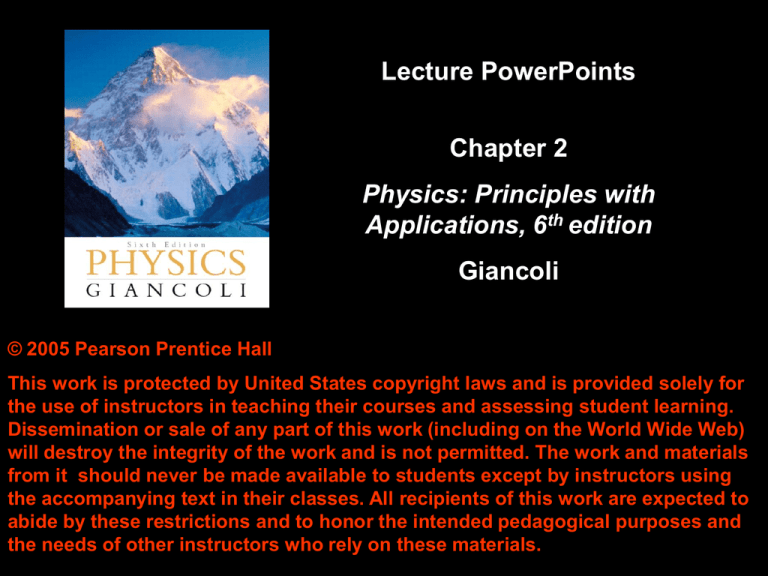
Lecture PowerPoints
Chapter 2
Physics: Principles with
Applications, 6th edition
Giancoli
© 2005 Pearson Prentice Hall
This work is protected by United States copyright laws and is provided solely for
the use of instructors in teaching their courses and assessing student learning.
Dissemination or sale of any part of this work (including on the World Wide Web)
will destroy the integrity of the work and is not permitted. The work and materials
from it should never be made available to students except by instructors using
the accompanying text in their classes. All recipients of this work are expected to
abide by these restrictions and to honor the intended pedagogical purposes and
the needs of other instructors who rely on these materials.
Chapter 2
Describing Motion:
Kinematics in One
Dimension
2-1 Reference Frames and Displacement
Any measurement of position, distance, or
speed must be made with respect to a
reference frame.
For example, if you are sitting on a train and someone
walks down the aisle, their speed with respect to the
train is a few miles per hour, at most. Their speed with
respect to the ground is much higher.
2-1 Reference Frames and Displacement
We make a distinction between distance and
displacement.
Displacement (blue line) is how far the object is
from its starting point, regardless of how it got
there.
Distance traveled (dashed line) is measured
along the actual path.
2-1 Reference Frames and Displacement
The displacement is written:
Left:
Right:
Displacement is positive.
Displacement is negative.
2-2 Average Velocity
Speed: how far an object travels in a given time
interval
(2-1)
Velocity includes directional information:
How far can a cyclist travel in 2.5 h along a
straight road if her average velocity is
18km/hr?
Do p. 39 #10
2-3 Instantaneous Velocity
The instantaneous velocity is the average
velocity, in the limit as the time interval becomes
infinitesimally short.
(2-3)
These graphs show (a)
constant velocity and (b)
varying velocity.
2-4 Acceleration
Acceleration is the rate of change of velocity.
2-4 Acceleration
Acceleration is a vector, although in onedimensional motion we only need the sign.
The previous image shows positive
acceleration; here is negative acceleration:
2-4 Acceleration
There is a difference between negative acceleration and
deceleration:
Negative acceleration is acceleration in the negative
direction as defined by the coordinate system.
Deceleration occurs when the acceleration is opposite
in direction to the velocity. The magnitude of the
velocity is decreasing.
2-4 Acceleration
The instantaneous acceleration is the average
acceleration, in the limit as the time interval
becomes infinitesimally short.
(2-5)
A car accelerates along a straight road from
rest to 75 km/h in 5.0 s. What is the
magnitude of its average acceleration?
If the velocity of an object is zero, does it
mean that the acceleration is zero?
If the acceleration is zero, does it mean that
the velocity is zero?
a=?
a=?
2-5 Motion at Constant Acceleration
The average velocity of an object during a time
interval t is
The acceleration, assumed constant, is
2-5 Motion at Constant Acceleration
In addition, as the velocity is increasing at a
constant rate, we know that
(2-8)
Combining these last three equations, we find:
(2-9)
2-5 Motion at Constant Acceleration
We can also combine these equations so as to
eliminate t:
(2-10)
We now have all the equations we need to solve
constant-acceleration problems.
(2-11a)
(2-11b)
(2-11c)
(2-11d)
Practice Problems
2-7 Falling Objects
Near the surface of the Earth, all objects
experience approximately the same acceleration
due to gravity.
This is one of the most
common examples of
motion with constant
acceleration.
2-7 Falling Objects
In the absence of air
resistance, all objects
fall with the same
acceleration, although
this may be hard to tell
by testing in an
environment where
there is air resistance.
2-7 Falling Objects
The acceleration due to
gravity at the Earth’s
surface is approximately
9.80 m/s2.
Figure 2-22
Tossing an object up
Practice Problems
Graphs of
(a) y vs. t
(b) v vs. t
for a ball thrown
upward.
2-8 Graphical Analysis of Linear Motion
This is a graph of x vs. t
for an object moving with
constant velocity. The
velocity is the slope of the
x-t curve.
2-8 Graphical Analysis of Linear Motion
On the left we have a graph of velocity vs. time
for an object with varying velocity; on the right
we have the resulting x vs. t curve. The
instantaneous velocity is tangent to the curve at
each point. What would an a vs. t graph look
like?
The velocity of an automobile as a function of time, starting
from a dead stop. The jumps in the curve represent gear
shifts.
2-8 Graphical Analysis of Linear Motion
The displacement, x,
is the area beneath
the v vs. t curve.
The shaded area represents the displacement during
the time interval t = 2.0s to t = 6.0s.




